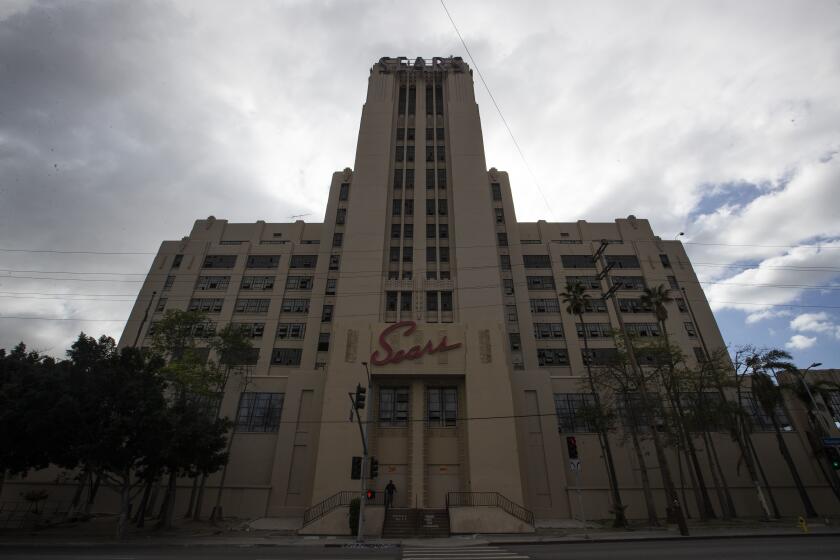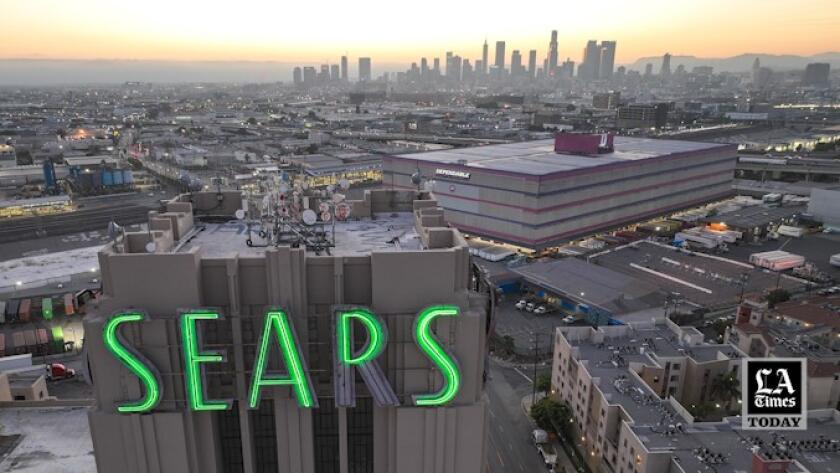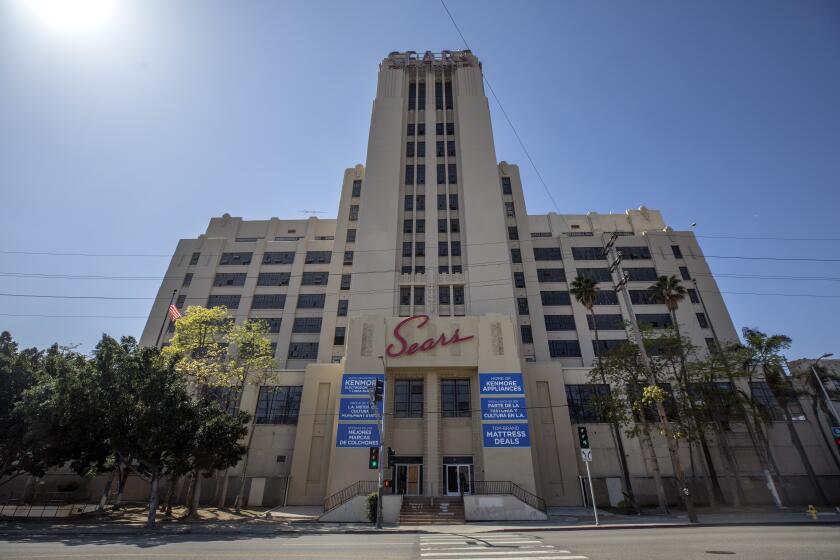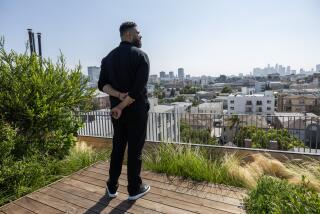Move thousands of homeless people into landmark L.A. Sears building? Some say no way
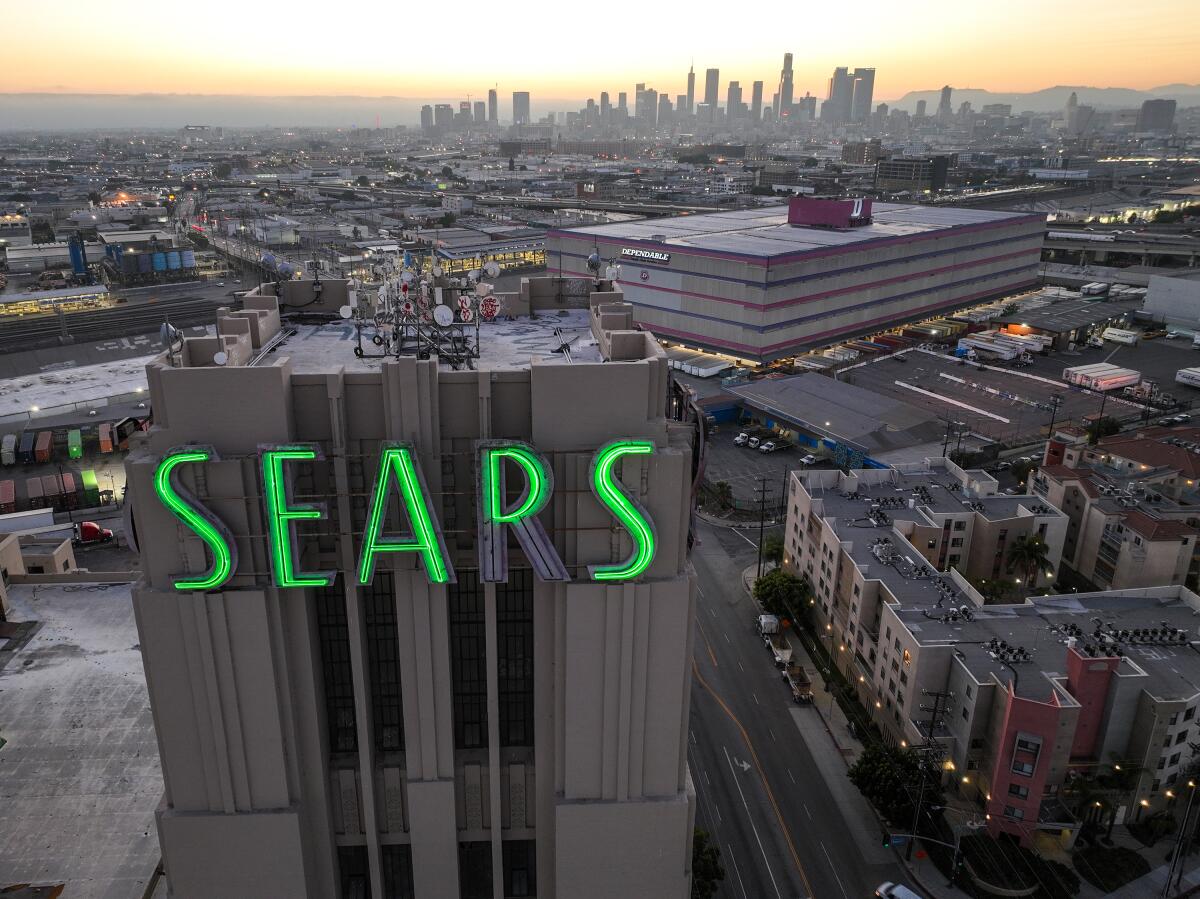
- Share via
Bill Taormina had 17 minutes to convince the crowd in the auditorium of Boyle Heights Resurrection School to back his plan to turn their shuttered neighborhood Sears into a giant homeless services hub.
The “Los Angeles Life Rebuilding Center” that Taormina wants to build would house up to 10,000 homeless people and provide medical and mental health services, job training, immigration help and drug abuse diversion programs.
The project would be dedicated to “saving lives,” Taormina told his audience, vowing not to build “anything like a prison” on the landmark lot.
As an activist, philanthropist and wealthy Anaheim businessman, Taormina has helped finance several homeless housing projects in Orange County over the years.
But in Boyle Heights, he was greeted with a sea of homemade poster board signs saying “No Sears Detention Center” and “Respect Our Community.” Dozens of speakers criticized his plan at the meeting June 27, calling it “a crime against humanity,” “irresponsible” and “a threat to the area’s children.” Shouts of “Take that to Beverly Hills!” were volleyed about.
The project felt to many attendees like a pie-in-the-sky approach to a problem that keeps growing exponentially. But the opposition on display at the meeting was about more than practicality.
It reflected the frustration of Boyle Heights residents who feel their community has been persistently shortchanged. Now, an outsider was telling them that the landmark Sears building, once the pride of the community, would house not hundreds, but thousands, of homeless people.
Can a historic, empty Sears building in Boyle Heights solve L.A.’s homeless issue?
“It was like a whole bunch of things were said, but nothing made sense,” lifelong Boyle Heights resident Jasmine Flores, 21, said after the meeting. “It seemed very much an unrealistic dream that we were being sold, while real solutions, things that could help people from Boyle Heights, weren’t considered.”
Some felt aggrieved that their community, already reeling from COVID-19 deaths and environmental pollution, was now supposed to “fix” Los Angeles’ massive homelessness crisis.
Others lamented that basic services they’ve demanded from city and county officials — street cleaning, affordable housing and better security — continued to be neglected, while homelessness has taken center stage.
Several speakers lambasted local elected representatives for skipping the meeting.
Flores was one of more than 30 people who spoke against the project. She said her family nearly wound up homeless on a few occasions during her childhood, and many in Boyle Heights are still barely making ends meet.
Like several other speakers, she considered it unfair that so many resources would be devoted to a transient community, rather than to residents who have been struggling for years.
“Many people don’t have health insurance or dental insurance — some can’t afford dialysis,” Flores said. “To wrap my head around hundreds of millions of dollars going to bring people from outside this community and help them settle, while ignoring us — it was too much.”
Meeting organizer Sofia Quiñones, leader of the East Los Angeles Boyle Heights Coalition, said the community’s lack of information regarding the project helped kindle residents’ outrage.

“We found out about this plan from an L.A. Times article,” she said. “It was unbelievable. I never heard anything from any politicians, any planners. How can you put this giant project in our backyard and not consult the community?”
For Quiñones and others, the lack of information about the plan harkened to when residents were left in the dark regarding the dangers of Exide Technologies lead battery recycling plant, which operated in neighboring Vernon.
In 2015, Exide acknowledged decades of illegal actions, including dumping contaminants, such as arsenic and lead, into the local air, soil and water. The facility put roughly 110,000 people in surrounding communities, including Boyle Heights, at increased risk for cancer.
Cleanup efforts to remove lead from the soil surrounding homes, businesses, schools and daycare centers won’t be completed until March 2025.
Taormina/Shomof plan to convert Sears Boyle Heights into the Los Angeles Life Rebuilding Center complex, which can rehabilitate up to 10,000 people.
After listening for hours to their concerns, Taormina asked the 200 people in attendance what they would accept.
Many said they wanted grocery and department stores, and others asked for parks and play spaces for children. Some wanted a training center and trade school that would help prepare residents for well-paying jobs.
“What’s ironic is a lot of what the community told me they wanted, after they vented and shared their ideas, was what this plan calls for,” Taormina said the day after the meeting.
According to project plans, the Los Angeles Life Rebuilding Center would include a retail and convenience store open to the public. Current big-rig parking lots on the Sears campus would be converted into grassy areas, and the center would offer property storage and job training in areas such as food service, security and cosmetology. It would house a Los Angeles Police Department substation and a staging area for the L.A. Fire Department. And all jobs at the facility would be open first to Boyle Heights residents.
- Share via
Watch L.A. Times Today at 7 p.m. on Spectrum News 1 on Channel 1 or live stream on the Spectrum News App. Palos Verdes Peninsula and Orange County viewers can watch on Cox Systems on channel 99.
But the sticking point is still the idea of 10,000 people moving onto the campus from the streets.
Los Angeles City Councilman Kevin de León, who represents Boyle Heights, said he saw “red flags” when first reviewing the project earlier this year. He was shocked by the scope, questioned the financing and worries that the city will eventually have to help fund the project.
“Situating 10,000 people, albeit temporarily, in one building and asking the city of L.A. to foot the bill is a non-starter,” said De León, who helped build a tiny home village with 98 beds in Eagle Rock earlier this year.
But Taormina said in an interview the day after the meeting that he doesn’t intend to scrap the project. Instead, he will consult with community leaders and incorporate their ideas into a new plan.
Quiñones said her group would invite Taormina and his business partner, Sears property owner Izek Shomof, to another meeting, with a promise to keep an open mind.
After all, there are other Boyle Heights constituencies to be polled about the vision Taormina and Shomof are promoting.
At Hollenbeck Park, the homeless community was holding out hope that the ambitious plan can survive.
“We need help, and if someone wants to help us, why is that a bad thing?” asked Jonathan Erik Estrada, a 34-year-old Mexico City native who slept in the park for 10 years.
Estrada struggled for years with a methamphetamine addiction, he said, before becoming sober four years ago, thanks in part to drug treatment services. He is now living in a Project Roomkey hotel in downtown L.A. and still visits his friends at the park.
But homeless people understand that their needs don’t resonate with everyone.
Most Boyle Heights residents had switched their shopping loyalties years ago. Still, the impending closure represents the end of an era for the working-class neighborhood.
Viridiana Hernandez, 38, said she’s been spit on, had bottles and trash thrown her way and had her tent set on fire while she was sleeping in it at Hollenbeck Park.
“Try to get medical help when you’re homeless, or a police officer to respond to a call about violence when you’re homeless. It’s difficult,” she said. “No one cares about you.”
Hernandez, who graduated from Garfield High School, said her slide into being unhoused began in 2016. Her husband died and she lost a baby during childbirth. “I was depressed for a long time,” she said. “I didn’t want to work and I was in a lot of emotional pain.”
Boyle Heights resident Aracelly Cauich has made a mission of helping homeless people in the area, including Hernandez, through her group, the Hummingbirds.
Cauich cooks meals, donates clothes, hygiene kits and blankets, and tries to keep Hollenbeck Park clean with the help of homeless volunteers.
“The people I work with have dignity and deserve to be treated with respect,” Cauich, 51, said. “It’s sad when I hear the community shut down an idea to help the homeless but don’t offer any help.”
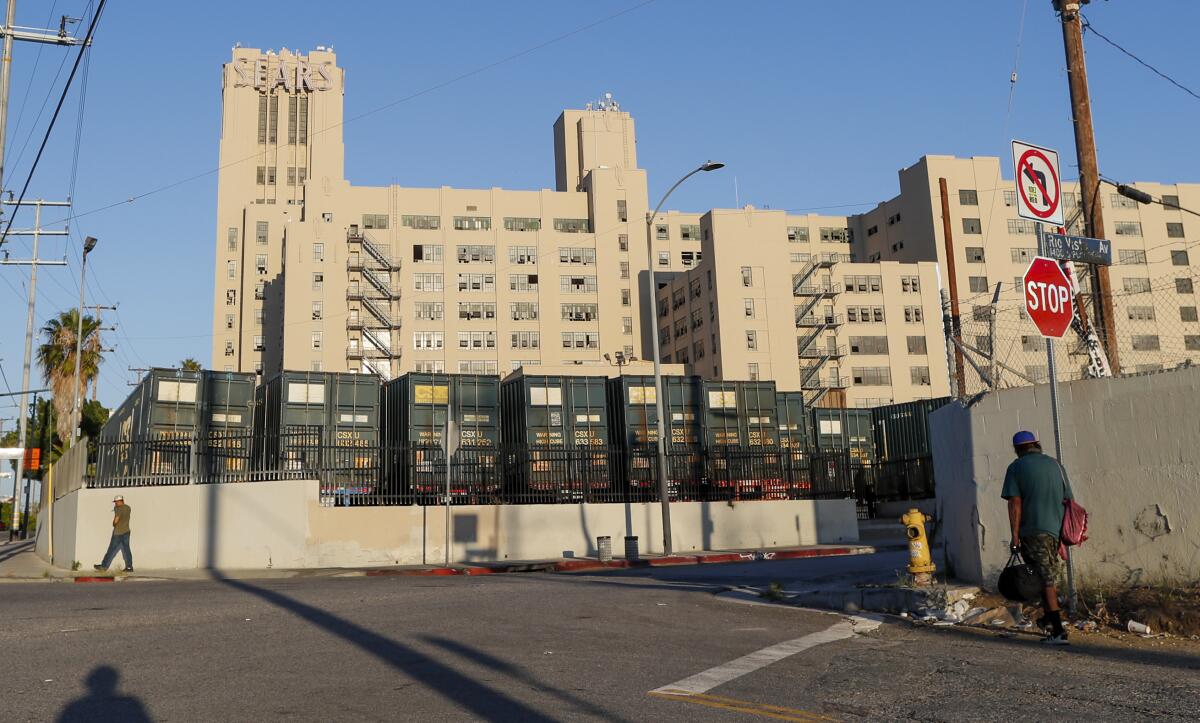
But Raquel Roman, executive director of Dolores Mission of Boyle Heights’ Proyecto Pastoral, which harbors about 45 men and 15 elderly women in a pair of shelters, said she was not surprised by the community reaction to the homeless services plan.
While she commended the vision behind the Los Angeles Life Rebuilding Center, her experience makes her question how feasible it is.
Roman said her organization relies on hundreds of workers to deal with 60 unhoused community members. They’ve found success in small settings, but only about 25% of Proyecto Pastoral clients transition out of the shelter and into permanent housing within a year or two.
“On one hand, a project that size may not be feasible for people experiencing homelessness,” she said. “But the area does need a lot more resources than are currently being offered.”
One thing everyone seemed to agree on was the need to renovate the Sears campus in a way that will make it a community asset.
The historic Sears building, built in 1927, has long served as a landmark, but the property is now home to trash and illegal dumping, said Jonathan Echeverria, the Boyle Heights Neighborhood Council’s Historical Preservation chair.
Still, Echeverria has encountered numerous homeless people whose mental health issues could pose a danger to community members, he said, and that risk has to be considered too.
“I just hope whatever takes the place of Sears upholds the character of Boyle Heights,” he said. “We have to put up with a lot in this community, and whatever comes in should be respectful of the neighborhood’s history and involve community input.”
More to Read
Sign up for Essential California
The most important California stories and recommendations in your inbox every morning.
You may occasionally receive promotional content from the Los Angeles Times.
